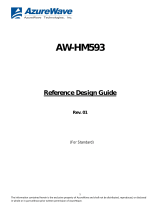
4
The information contained herein is the exclusive property of AzureWave and shall not be distributed, reproduced, or disclosed
in whole or in part without prior written permission of AzureWave.
2. Ground Layout
Please
follow
general
powe
r
layout
guidelines. Here are some general rules for customers’
reference.
(1) The top layer of customer platform should keep
complete ground plane as possible as
you can, in order to be connected for all ground pins of AW-CU484 module
.
(2) The area under our module forbidden any trace and via on top layer of customer platform.
3. Power Layout
Please
follow
general
powe
r
layout
guideline
s.
Here
are
some
gene
r
al
rules
for
customer
s’
ref
eren
ce.
(1) Power traces shall surround ground to get stable and make sure all power traces have
good return path to ground.
(2) Do not get close to digital traces (SDIO.USB) or continuous data traces, there could be
coupling noise affect power traces and IC.
4. Digital Interface
Please
follow
powe
r and ground
layout
guideline
s.
Here
are
some
gene
r
al
rules
for
customer
s’
ref
eren
ce.
(1) The digital I
nterfa
c
e
to
the
module
must
be well
routed to
minimize
coupling
to
powe
r
planes and other digital signals.
(2) SDIO and UART Traces need GND surrounded.
(3) SDIO pin can add pull high resistor on traces close WIFI module.(reserved solution)
(4) SDIO and UART traces between host and module are shot as possible.
(5) SDIO Traces length between host and module is equal as possible.
(6) SDIO & UART traces as possible away from CLOCK signal
5.
RF
Trace
The RF trace is the critical to route. Here are some general rules for customers’ reference.
(1)
The
RF
trace
impedance
should
be
50Ω
between
ANT
port
and
antenna matching
network.
(2)
The
length
of
the
RF
trace
should
be
minimized.












